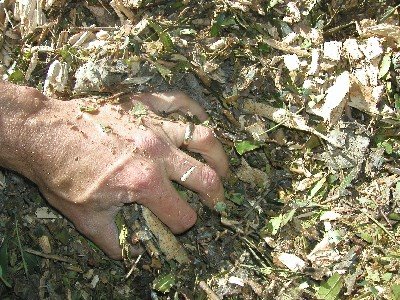 Oooo, isn't that sexy? A nekkid hand in the raw wood chips? Why, you may ask, do I have wood chips? What? Isn't that the very first thing a new homeowner does? Calls the local tree service and has a load of wood chips dropped by?
Oooo, isn't that sexy? A nekkid hand in the raw wood chips? Why, you may ask, do I have wood chips? What? Isn't that the very first thing a new homeowner does? Calls the local tree service and has a load of wood chips dropped by? Why yes, that's what I did. I called Drew over at Forest Tree and got 3-ish yards of wood chips. In permaculture class, I learned what a valuable resource wood chips are. Happily, arborists get charged money to take this stuff to the landfill, so they will generally bring it to your place for free. Free! For a resource that is locally grown, probably carrying a very low load of toxics, and is useful as a groundcover for weed control, erosion control, and a carbon source for pee-pee ponics!
Why yes, that's what I did. I called Drew over at Forest Tree and got 3-ish yards of wood chips. In permaculture class, I learned what a valuable resource wood chips are. Happily, arborists get charged money to take this stuff to the landfill, so they will generally bring it to your place for free. Free! For a resource that is locally grown, probably carrying a very low load of toxics, and is useful as a groundcover for weed control, erosion control, and a carbon source for pee-pee ponics!"Pee-pee ponics!?"
I learned about so much stuff, from a high-level systems viewpoint, in that permaculture class. For example, commercial fertilizer is petroleum based. It is used to overdose dead soil with nitrogen. Food crops are grown and harvested, then transported an average of 1300 miles. We consume the food and excrete the nitrogen in our urine. Urine is generally sterile, but we mix it with "black water" in our toilets. Next, our waste treatment plant has to deal with "fertilizer" mixed with blackwater. This costs alot of money and energy to treat so the water can be released.
One human's nitrogen excretion= one human's worth of nitrogen for food crops.
So, why not use this resource on-site? I learned from Nik Bertulis how urine, with its nitrogen (and its phosphorous) can be used to fertilize crops from underneath, using a carbon source (such as wood chips) to provide a matrix, and a carbon source, to provide the chemistry for the carbon::nitrogen cycle.
 This is the raised bed I built, showing the wood chips and the plumbing I put in to deliver urine. The hose has perforations in it. I buried it under about 4 inches of wood chips and about 6 inches of soil.
This is the raised bed I built, showing the wood chips and the plumbing I put in to deliver urine. The hose has perforations in it. I buried it under about 4 inches of wood chips and about 6 inches of soil.
And then I planted corn, beans and zuchinni. My friend Steph suggested a vapor barrier, to hold in moisture. That's the plastic you see here. She explained that if my urinal was ever made available for public use, I'd want to ensure that any pathogens couldn't escape. They'll be trapped and broken down by the micro-ecology that will form inside the bed.
Hopefully, even a heavy-feeder crop like corn will do just fine, with a nitrogen and phosphorous source being steadily applied to its roots.

No comments:
Post a Comment